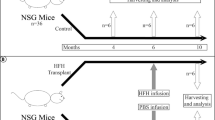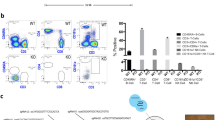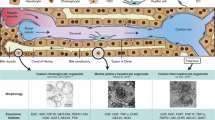Abstract
Hepatocyte transplantation might represent a potential therapeutic alternative to liver transplantation in the future1,2; however, transplanted cells have a limited capacity to repopulate the liver, as they do not proliferate under normal conditions. Recently, studies in urokinase (uPA) transgenic mice3,4,5 and in fumarylacetoacetate hydrolase (FAH)-deficient mice6 have shown that the liver can be repopulated by genetically engineered hepatocytes harboring a selective advantage over resident hepatocytes7. We have reported that transgenic mice expressing human Bcl-2 in their hepatocytes are protected from Fas/CD95-mediated liver apoptosis8. We now show that Bcl-2 transplanted hepatocytes selectively repopulate the liver of mice treated with nonlethal doses of the anti-Fas antibody Jo2. FK 506 immunosuppressed mice were transplanted by splenic injection with Bcl-2 hepatocytes. The livers of female recipients were repopulated by male Bcl-2 transgenic hepatocytes, as much as 16%, after 8 to 12 administrations of Jo2. This only occurred after anti-Fas treatment, confirming that resistance to Fas-induced apoptosis constituted the selective advantage of these transplanted hepatocytes. Thus, we have demonstrated a method for increasing genetic reconstitution of the liver through selective repopulation with modified transgenic hepatocytes, which will allow optimization of cell and gene therapy in the liver.
This is a preview of subscription content, access via your institution
Access options
Subscribe to this journal
Receive 12 print issues and online access
$209.00 per year
only $17.42 per issue
Buy this article
- Purchase on Springer Link
- Instant access to full article PDF
Prices may be subject to local taxes which are calculated during checkout


Similar content being viewed by others
References
Fox, I.J. et al. Brief Report: Treatment of the Crigler-Najjar Syndrome Type I with Hepatocyte Transplantation. N. Engl. J. Med. 338, 1422 (1998).
Lake, J.R. Hepatocyte Transplantation. N. Engl. J. Med. 328, 1463 (1998).
Sandgren, E.P. et al. Complete hepatic regeneration after somatic deletion of an albumin-plasminogen activator transgene. Cell 66, 245–256 (1991).
Rhim, J.A., Sandgren, E.P., Degen, J.L., Palmiter, R.D. & Brinster, R.L. Replacement of diseased mouse liver by hepatic cell transplantation. Science 263, 1149–1152 (1994).
Rhim, J.A., Sandgren, E.P., Palmiter, R.D. & Brinster, R.L. Complete reconstitution of mouse liver with xenogeneic hepatocytes. Proc. Natl. Acad. Sci. USA 92, 4942– 4946 (1995).
Overturf, K. et al. Hepatocytes corrected by gene therapy are selected in vivo in a murine model of hereditary tyrosinaemia type I. Nature Genet. 12, 266–273 ( 1996).
Wilson, J.M. Round two for liver gene therapy. Nature Genet. 12, 232–233 (1996).
Lacronique, V. et al. Bcl-2 protects from lethal hepatic apoptosis induced by an anti-Fas antibody in mice. Nature Med. 2, 80–86 (1996).
Vrancken Peeters, M.J., Patijn, G.A., Lieber, A., Perkins, J. & Kay, M.A. Expansion of donor hepatocytes after recombinant adenovirus-induced liver regeneration in mice. Hepatology 25, 884–888 (1997).
Ponder, K.P. et al. Mouse hepatocytes migrate to liver parenchyma and function indefinitely after intrasplenic transplantation. Proc. Natl. Acad. Sci. USA 88, 1217–1221 ( 1991).
Snyder, R.O. et al. Persistent and therapeutic concentrations of human factor IX in mice after hepatic gene transfer of recombinant AAV vectors. Nature Genet. 16, 270–276 (1997).
Kafri, T., Blomer, U., Peterson, D.A., Gage, F.H. & Verma, I.M. Sustained expression of genes delivered directly into liver and muscle by lentiviral vectors. Nature Genet. 17, 314–317 ( 1997).
Yang, E. & Korsmeyer, S.J. Molecular thanatopsis: a discourse on the Bcl-2 family and cell death. Blood 88, 386–401 (1996).
Nagata, S. Apoptosis by death factor. Cell 88, 355– 365 (1997).
Galle, P.R. et al. Involvement of the CD95 (APO-1/Fas) receptor and ligand in liver damage. J. Exp. Med. 182, 1223– 1230 (1995).
Berry, M.N. & Friend, D.S. High-yield preparation of isolated rat liver parenchymal cells: a biochemical and fine structural study. J. Cell. Biol. 43, 506–520 (1969).
Sambrook, J., Fritch, E.E. & Maniatis, T. Molecular Cloning : A Laboratory Manual, 2nd edn. (Cold Spring Harbor Laboratory, New York, 1989).
Acknowledgements
We thank J. Chelly for discussions and N. McDonell for help during preparation of the manuscript, and N. Ba and L. Castelneau-Ptakhine for technical assistance. This work was supported in part by grants from Association Francaise contre les Myopathies. J.E.G received sponsorship from Vaincre les Maladies Lysosomales and C.M has a fellowship from CNPq-Brazil.
Author information
Authors and Affiliations
Corresponding author
Rights and permissions
About this article
Cite this article
Mignon, A., Guidotti, J., Mitchell, C. et al. Selective repopulation of normal mouse liver by Fas/CD95-resistant hepatocytes . Nat Med 4, 1185–1188 (1998). https://doi.org/10.1038/2681
Received:
Accepted:
Issue Date:
DOI: https://doi.org/10.1038/2681
This article is cited by
-
Functional characterization of CD49f+ hepatic stem/progenitor cells in adult mice liver
Journal of Molecular Histology (2022)
-
Messenger RNA-based therapeutics for the treatment of apoptosis-associated diseases
Scientific Reports (2015)
-
Overexpression of Bcl-2 in hepatocytes protects against injury but does not attenuate fibrosis in a mouse model of chronic cholestatic liver disease
Laboratory Investigation (2011)
-
Fetal liver cell transplantation as a potential alternative to whole liver transplantation?
Journal of Gastroenterology (2011)
-
Human hepatocyte transplantation: current experience and future challenges
Nature Reviews Gastroenterology & Hepatology (2010)



